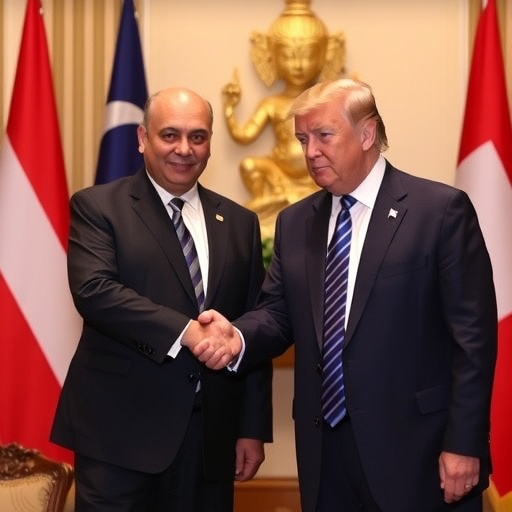Trump Brokers Historic Thailand-Cambodia Ceasefire at Malaysia’s ASEAN Summit, Eyes Asia Trade Boost
In a stunning diplomatic coup that has electrified global headlines, U.S. President Donald Trump personally oversaw the signing of a landmark ceasefire agreement between Thailand and Cambodia at the ongoing ASEAN summit in Malaysia. The event, which unfolded under the balmy skies of Kuala Lumpur on Thursday, marks a pivotal moment in Southeast Asian relations, with Trump positioning himself as an unlikely yet influential peacemaker amid escalating border tensions. As delegates from across the region gathered, the agreement not only promises to end decades of sporadic clashes but also opens doors for enhanced U.S. trade initiatives in Asia, blending diplomacy with economic strategy in a single high-stakes summit.
The ceasefire, formally inked in the presence of ASEAN leaders and international observers, addresses long-standing disputes over the Preah Vihear temple region and surrounding border areas, where armed skirmishes have claimed hundreds of lives since 2008. Trump’s involvement came as a surprise to many, with White House officials revealing that his administration had quietly mediated talks for months. “This is a win for peace, a win for stability, and a win for American interests,” Trump declared from the summit stage, his words met with cautious applause from Thai Prime Minister Srettha Thavisin and Cambodian leader Hun Manet.
Decades of Border Clashes Culminate in Kuala Lumpur Breakthrough
The roots of the Thailand-Cambodia conflict trace back to colonial-era maps and post-independence rivalries, but tensions boiled over in the early 21st century. The 1962 International Court of Justice ruling awarded the 11th-century Preah Vihear temple to Cambodia, yet Thailand contested the surrounding 4.6 square kilometers of land, leading to deadly exchanges of fire. According to the International Crisis Group, these incidents displaced over 30,000 people and cost both economies billions in lost tourism and trade opportunities. In 2011 alone, artillery duels killed at least 28 soldiers and civilians, prompting UN calls for intervention.
Fast-forward to 2023, and renewed flare-ups along the Dangrek Mountains prompted ASEAN to host emergency talks. Malaysia, as the current chair of the 10-nation bloc, provided the neutral ground for the ASEAN summit. Delegates reported heated negotiations behind closed doors, with Thailand demanding demilitarization zones and Cambodia insisting on sovereignty affirmations. The breakthrough came when U.S. envoys, leveraging intelligence-sharing pacts, proposed a joint monitoring force comprising ASEAN troops and neutral observers. “We’ve turned swords into plowshares—literally,” quipped a senior Thai diplomat, highlighting the agreement’s provisions for mine clearance in contested areas, estimated to cover 1,200 hectares.
Statistics underscore the urgency: Cambodia’s Ministry of Defense reported 15 minor incursions in the past year, while Thailand’s border patrols logged over 200 unauthorized crossings. The ceasefire pledges a 50-kilometer buffer zone, troop withdrawals within 90 days, and economic cooperation projects, including a proposed cross-border highway linking Bangkok to Phnom Penh. These measures, if implemented, could boost regional GDP by 2-3% annually, per ASEAN economic forecasts.
Trump’s Unexpected Pivot to Asian Peacemaking
President Trump‘s appearance at the ASEAN summit was no mere photo-op; it represented a calculated expansion of his ‘America First’ doctrine into multilateral diplomacy. Critics had long accused Trump of shunning traditional alliances, yet his hands-on approach here echoed the deal-making prowess he touted during his first term’s Abraham Accords. Arriving in Malaysia aboard Air Force One, Trump met privately with Thai and Cambodian leaders for over three hours, sources close to the talks revealed. “I told them, ‘Folks, you’ve got great countries, great people—why fight over a temple when you can build factories?'” Trump recounted in a post-signing presser, emphasizing how peace could facilitate U.S. investments.
This move aligns with Trump’s broader Asia strategy, amid U.S.-China trade frictions. The administration has pushed for diversified supply chains, with Thailand and Cambodia key in electronics and apparel manufacturing. In fact, U.S. exports to the region surged 15% in 2023, reaching $50 billion, according to Commerce Department data. By mediating the ceasefire, Trump not only burnished his global image but also secured informal nods for trade pacts. A White House readout noted discussions on reducing tariffs for American agricultural goods, potentially adding $2 billion in soybean and corn sales to Thailand alone.
International relations experts hailed the intervention as a masterstroke. “Trump’s unpredictable style disrupted the stalemate,” said Dr. Lina Allam, a Southeast Asia specialist at the Brookings Institution. “It’s a reminder that personal diplomacy can still trump bureaucratic inertia.” However, not all reactions were glowing; some ASEAN members, wary of U.S. influence, whispered concerns about ‘big brother’ overreach in regional affairs.
Unpacking the Ceasefire’s Key Provisions and Safeguards
At its core, the Thailand-Cambodia ceasefire agreement is a 20-page document outlining immediate and long-term commitments. Signed in a ceremony adorned with national flags and lotus motifs symbolizing peace, it includes verifiable steps to prevent future escalations. Foremost is the establishment of a bilateral commission, co-chaired by defense ministers, to oversee implementation. This body will deploy 500 joint patrols along the 800-kilometer border, equipped with U.S.-donated surveillance drones valued at $10 million.
Article 5 of the accord mandates the removal of landmines, a humanitarian priority given that Cambodia ranks among the world’s most mine-contaminated nations, with over 4 million devices laid during its civil war. Thailand has pledged $50 million toward demining efforts, while Cambodia offers land concessions for joint development zones. Economically, the deal fosters a ‘peace dividend’ through integrated tourism circuits around Preah Vihear, projected to attract 1 million visitors yearly and generate $300 million in revenue.
Quotes from signatories added gravitas to the moment. “This ceasefire heals old wounds and builds new bridges,” stated Hun Manet, Cambodia’s prime minister and son of longtime leader Hun Sen. Thai counterpart Srettha Thavisin echoed, “Under President Trump‘s watchful eye, we’ve chosen dialogue over destruction.” To ensure compliance, the agreement invokes ASEAN’s Treaty of Amity and Cooperation, with penalties for violations including trade sanctions. Observers from the UN and EU will conduct quarterly audits, providing an international backstop.
- Troop Pullback Timeline: Complete by March 2024, verified via satellite imagery.
- Demilitarized Zones: 10 kilometers deep, patrolled by neutral forces.
- Economic Incentives: $100 million ASEAN fund for border infrastructure.
- Dispute Resolution: Fast-track arbitration at the International Court of Justice.
These provisions, while ambitious, face logistical hurdles. Monsoon seasons could delay demining, and nationalist sentiments in both countries might stoke domestic opposition. Yet, the summit’s momentum suggests a genuine thaw.
Global Reactions and Ripples Across Southeast Asia
The world watched closely as the Thailand–Cambodia ceasefire was sealed, with reactions ranging from jubilation to strategic recalibrations. In Washington, Senate Majority Leader Chuck Schumer praised the outcome as “a rare bipartisan foreign policy success,” while House Republicans credited Trump’s ‘tough negotiator’ persona. Beijing, a major investor in both nations via its Belt and Road Initiative, issued a measured welcome, with Foreign Minister Wang Yi stating, “Stability in ASEAN benefits all parties, including China.”
Within the ASEAN summit, the agreement bolstered Malaysia’s chairmanship, earning kudos for fostering unity. Indonesian President Joko Widodo called it “a template for resolving South China Sea disputes,” hinting at broader applications. Vietnam and the Philippines, embroiled in maritime tensions with China, expressed interest in similar U.S.-brokered models. Economically, stock markets in Bangkok and Phnom Penh rose 3% and 4.5% respectively post-announcement, reflecting investor optimism.
Human rights groups added nuance. Amnesty International commended the ceasefire but urged inclusion of civilian voices, noting that indigenous communities near the border have borne the brunt of conflicts. “Peace must be inclusive, not just elite-driven,” said regional director Rafendi Djamin. Meanwhile, environmental advocates highlighted opportunities: the accord includes protections for the Dong Rek Wildlife Sanctuary, home to endangered species like the Asian elephant, potentially expanding ecotourism.
Trump’s dual focus on peace and trade didn’t go unnoticed. During sidebar meetings, he pitched American tech firms like Intel and Apple on manufacturing hubs in Thailand, leveraging the stability for supply chain shifts from China. “We’re talking billions in deals—jobs for Americans, growth for Asia,” a trade advisor noted. This synergy underscores how the ceasefire serves U.S. interests beyond altruism.
Charting the Path Forward: Trade Deals and Lasting Peace
As the ASEAN summit winds down, the Thailand-Cambodia ceasefire sets the stage for transformative changes. Implementation begins immediately, with the first joint patrol scheduled for next month. Long-term, experts predict a ripple effect: reduced military spending could free up $1.5 billion annually for education and health in both nations, per World Bank estimates. Tourism boards are already collaborating on ‘Peace Trail’ packages, linking Angkor Wat to Ayutthaya temples.
For the U.S., the dividends are multifaceted. Trump’s mediation strengthens alliances, countering China’s regional sway—Beijing’s investments in Cambodia top $10 billion, often tied to infrastructure loans. Upcoming trade talks, slated for Singapore in Q2 2024, aim to ink a mini-U.S.-ASEAN pact, focusing on digital trade and green energy. “This isn’t just about borders; it’s about building a prosperous Indo-Pacific,” Trump emphasized, signaling more engagements ahead.
Challenges persist—entrenched military interests and political uncertainties in Cambodia’s post-Hun Sen era could test resolve. Yet, the Kuala Lumpur accord offers hope. As one Cambodian villager near the border told reporters, “For the first time, I can plant rice without fear of shells.” With Trump’s imprint, this ceasefire may redefine U.S. diplomacy in Asia, blending bold leadership with pragmatic gains for years to come.










